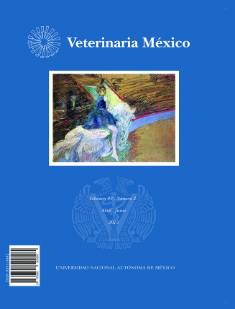Prostatic carcinoma in dog. Case report
Main Article Content
Abstract
Dogs and humans are the only species that with a certain degree of frequency develop naturally prostatic carcinoma. The prostatic carcinoma (PC) is a neoplasia which originates from the glandular epithelium of the prostate. In dogs, the frequency of appearance varies from 0.29 to 0.6% and there is no evidence of predisposition factors that favor its development; in humans there are a considerable number of factors that can be observed, like fat rich diets, genetics, among other causes. Four histological patterns have been described in dogs: tufting, micropapillar, cribriform and flat, being the former the most common. These tumors have a high metastatic rate, being the sites of incidence the regional lymph nodes, lungs and bones. The present case corresponds to an 11 year old Labrador dog that began with anorexia, prostration and lameness of the left pelvic member (LPM), progressive deterioration and no response to treatment; it had to be euthanized and necropsy was performed. At the macroscopic examination, the most outstanding findings were thrombosis in jugular veins, generalized lymph node enlargement and multiple mineralization zones in the muscles that surround the left pelvic member. Whereas in the prostate, multiple white yellowish well delimited nodules from 0.5 to 0.7 cm in diameter were found. Such nodules were constituted by neoplastic glandular epithelial cells. These cells were observed invading blood and lymphatic vessels of different organs, like muscles, skin, lung, liver, kidney, intestines, testicles and meninges. The final diagnosis of prostatic carcinoma was determined by the histological and ultrastructural characteristics and biological behavior.
Keywords:
Carcinoma, Prostate, Dogs, Metastasis
Article Details
License

Veterinaria México OA by Facultad de Medicina Veterinaria y Zootecnia - Universidad Nacional Autónoma de México is licensed under a Creative Commons Attribution 4.0 International Licence.
Based on a work at http://www.revistas.unam.mx
- All articles in Veterinaria México OA re published under the Creative Commons Attribution 4.0 Unported (CC-BY 4.0). With this license, authors retain copyright but allow any user to share, copy, distribute, transmit, adapt and make commercial use of the work, without needing to provide additional permission as long as appropriate attribution is made to the original author or source.
- By using this license, all Veterinaria México OAarticles meet or exceed all funder and institutional requirements for being considered Open Access.
- Authors cannot use copyrighted material within their article unless that material has also been made available under a similarly liberal license.



